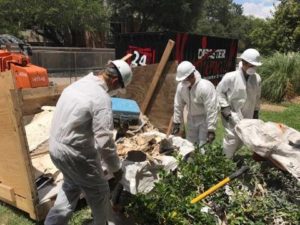 You can trust us when we say that something you never want to see inside your commercial property is mold. It smells, it spreads rapidly, and it can make you extremely ill. But living in Houston and being no strangers to floods and hurricanes, we experience mold more than other areas do. Especially after Hurricane Harvey.
You can trust us when we say that something you never want to see inside your commercial property is mold. It smells, it spreads rapidly, and it can make you extremely ill. But living in Houston and being no strangers to floods and hurricanes, we experience mold more than other areas do. Especially after Hurricane Harvey.
After natural disasters like hurricanes, tornadoes, and floods, excess moisture and standing water contribute to the growth of mold in homes and buildings. The devastation from Hurricane Harvey caused mold growth in thousands of commercial and residential properties, causing health threats to millions of Texans. The wet conditions from the storm, mixed with our warm, damp climate created the perfect conditions for mold to thrive.
So what exactly is mold?
“Mold and mildew are commonly used interchangeably, although mold is often applied to black, blue, green and red fungal growth and mildew to whitish growths. Molds produce tiny spores to reproduce. When mold spores land on a damp spot indoors, they begin growing and digesting whatever they are growing on in order to survive. Molds thrive on a great many organic substances and provided with sufficient moisture, they rapidly disintegrate wood, paper and leather. There is no practical way to eliminate all mold and mold spores in the indoor environment,” says the CDC.
Basically, a high moisture level in the air can eventually lead to mold growth if you are not careful. And sometimes no matter how careful you are, mold will still start to form. According to the EPA, the increase in cases of toxic mold infestations in both public and private buildings is partially due to the use of imitation masonry materials that allow building leaks and subsequent trapping of water inside the walls. This provides a perfect breeding ground for toxic mold. The problem is far more prevalent in humid areas like Houston and is compounded by flooding.
Mold is toxic, and any time there is the smallest amount of mold growth inside a building it needs to be removed immediately. Breathing in mold spores is very dangerous, and is harmful to anyone and everyone. Although it is harmful to all, it is especially dangerous to the elderly, young children, and people who suffer from respiratory issues. Mold growth is directly correlated to the following symptoms:
- Nasal and sinus congestion
- Cough/sore throat
- Chest tightness
- Dyspnea (difficulty breathing)
- Asthma
- Nosebleed
- Upper respiratory infections
- Headache
- Skin and eye irritation
Because we live in a warm and humid climate, we are naturally prone to having mold grow inside, but that doesn’t mean there isn’t anything we can do about it. Thankfully, the CDC has developed a list of what you should know about mold so you can prevent it:
- There is no practical way to eliminate all mold and mold spores in the indoor environment: the way to control indoor mold growth is to control moisture.
- If mold is a problem in your home or workplace, you must clean up the mold and eliminate sources of moisture.
- Fix the source of water problem or leak to prevent mold growth.
- Reduce indoor humidity (to 30-50%) to decrease mold growth by ventilation using air conditioners, dehumidifiers and exhaust fans.
- Clean and dry any damp or wet building materials to prevent mold growth. Clean mold off hard surfaces with a mixture of water and detergent and dry completely.
- In areas where there is a continuous moisture problem, do not install carpeting.
We have worked with businesses all over removing mold and rebuilding the damage that the mold has caused. Mold needs to be dealt with as soon as possible. And an important thing to keep in mind is that if there is mold on the walls, ceiling, or doors of your commercial property, then the buildings insides, like the vents and interior walls, need to be checked also. Mold growth is very common inside air ducts and near the AC system because of the condensation that forms in the unit. Stay vigilant about mold growth, and keep Disaster America in mind if you see any mold forming inside your commercial property.
